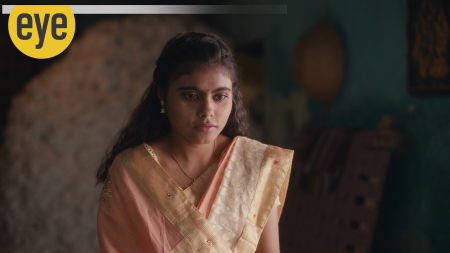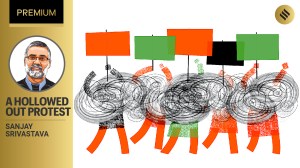- India
- International
Villages where building a toilet is considered bad luck
In many villages, an open wall called the “Maryada Ghode” or the “wall of respect” serves as a public toilet for most, including women.
 A Maryada Ghode, or wall of respect, the area behind which villagers use as a toilet. (Source: Express photo)
A Maryada Ghode, or wall of respect, the area behind which villagers use as a toilet. (Source: Express photo)
In his Independence Day speech, Prime Minister Narendra Modi called for universal access to toilets. In parts of Karnataka, however, convincing people to use a toilet is proving a mountainous task against established mindsets and cultural beliefs.
Early every morning during his tenure as a zilla panchayat president in Koppal of north Karnataka last year, Janardhan Hulagi would walk around villages with gram panchayat officials and children, blowing a whistle to discourage people from defecating in the open. “The intention was not to humiliate them but to tell them that they need to build a toilet,” says Hulagi.
“In these parts of the country it is traditionally considered unholy to install a toilet at homes,” says Baburao, a member of the Sukarwadi gram panchayat in Aland taluka of Gulbarga district. “People think it will bring bad luck.” Lack of knowledge of underground drainage systems is one of the reasons for people’s reluctance, he says.
Such reluctance runs across several villages in the districts of Gulbarga, Bidar, Yadgir, Raichur, Koppal, Bellary, Bijapur, Bagalkote, Gadag and Haveri. In many villages, an open wall called the “Maryada Ghode” or the “wall of respect” serves as a public toilet for most, including women.
“The wall of respect has no drainage system and is unhygienic for villages,” says Mallikharjuna, panchayat development officer at Sangwara in Yadgir village, who has been leading a movement to create household toilets. He summoned a baba recently to advise villagers to use toilets. “The unconventional experiment was quite a success. Many villagers are now willing to use toilets,” says Sathish Kumar, nodal officer for Nirmal Bharat Abhiyan (the government’s toilet construction programme) in Yadgir zilla panchayat.

Sukarwadi village in Gulbarga, incidentally, stands as an island of defiance against the practice of open defecation. Each of the 133 independent houses in the village today has a toilet and the gram panchayat has been declared 100 per cent compliant with toilet construction under the Nirmal Bharath Abhiyan.
Sukarwadi won that status after a nearly two-year-long struggle. When Mahadev Mane, an ex-serviceman also known as “Military Mane” by locals, first set up an Indian-style toilet at his house two years ago, relatives from neighbouring villages stopped visiting his home. “In front of us they would appreciate the idea of having a toilet, but they would later complain about it not being vastu-compliant,” Mane says.
“In rural areas, household latrines are very rare. People prefer to go to farms, railway tracks or isolated areas,” says Meena Nagraj, additional director of NBA in Karnataka. This has led to parts of the region seeing outbreaks of cholera, malaria, diarrhoea, typhoid and jaundice, especially among children, she says.
The cost of construction, too, is sometimes a hurdle. “We receive only Rs 10,000 from the government for constructing toilets but the actual cost is not less than Rs 50,000. Only those who are well off can afford a toilet at home,” says Thukaram, an agriculturist. NBA’s Nagaraj points out, “NBA is not a subsidy programme but an incentive-based model that provides families assistance for construction.”
Must Read
May 11: Latest News
- 01
- 02
- 03
- 04
- 05





































